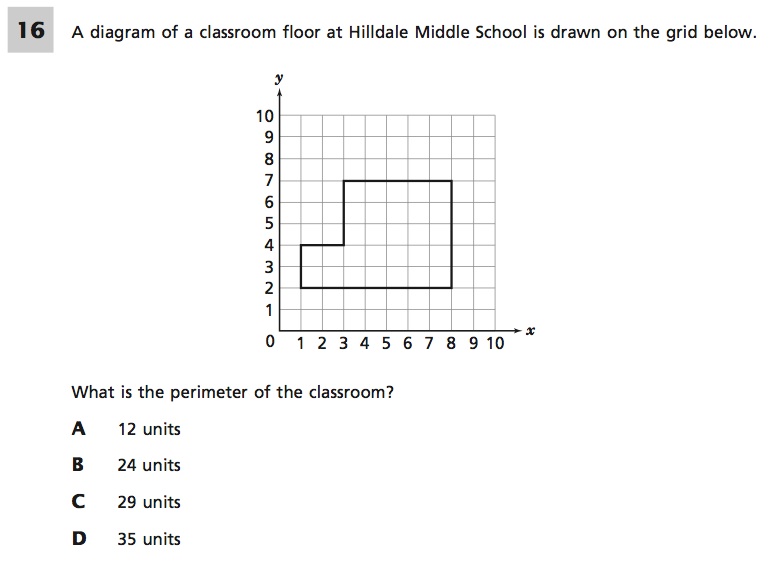Item of the Week
This week’s testing item is a favorite of mine to use as an example, because it illustrates just how careful we need to be when looking at standardized testing data.
We will be looking at Item 16 on the 2009 New York State Grade 6 Exam. The performance indicator is “5.G14 Calculate perimeter of basic geometric shapes drawn on a coordinate plane (rectangles and shapes composed of rectangles having sides with integer lengths and parallel to the axes).” You can click the figure below to enlarge.

What is this question testing? Does it fit the performance indicator? Which of the wrong answers would you predict students would choose the most often? Why? What would students need to know and be able to do to answer this question correctly?
April 3rd, 2011 at 11:37 pm
Answer choice C is the obvious “wrong” answer – it’s the situation where a student has confused perimeter and area.
Answer choice A is what a student would get if they merely counted the number of squares that is the length of the bottom line and the right most line.
Answer choice D is what the students would get if they merely counted the two longest sides (5 and 7) and multiplied.
Answer choice B, 24, is the correct perimeter – the answer that demonstrates that the student doesn’t just use the formula without understanding, but actually adds up the number of boxes around the edge.
I think it fits pretty well – what do you think?
April 7th, 2011 at 6:23 am
Welcome, Kit!
I really like your distractor analysis (I had not considered the reasoning behind A and D), but I disagree with your conclusion. However, I have more information than I presented above. Perhaps you will find it convincing.
One factor the teachers noticed is that the students were used to seeing this kind of grid and being asked the area. They were basically trained to count the squares when they saw a closed figure on a grid. Many may not have even bothered to read the question.
In the school that was examining this question, 32% picked the correct answer B, and 61% chose C.
Looking at it another way, 93% of the students accurately identified either the area or the perimeter. So I think the issue here is less with math and more with something else. Stamina? Vocabulary? Test-taking skills? In my opinion, this question does not really test what it purports to test.
Of course, I formed that opinion based on the distractor pattern, which I didn’t provide in the post above. I found it telling that so many students chose the correct answer to the wrong question.